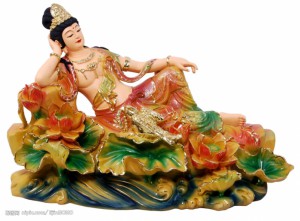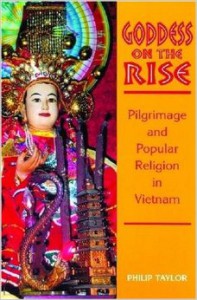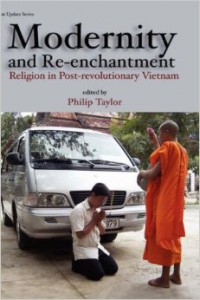CONTINUATION OF GOD-Dess Capital-ISM, Part 1.
By Donald Meinshausen
Following the fall of South Vietnam to the advancing communist armies the economy fell into chaos. Normal trade was forbidden. Communist ideology forbids that. It also forbids dissent. And so was religion at first.
This religious repression was an old tradition in Vietnam. The Confucianism of the Chinese conquerors was against the native religions. The Nguyen dynasty before the French occupation had whippings as punishment for fortune-tellers as well as hard labor. The French and the Diem regime that followed also passed laws against the worshippers of the Goddess so as to help the Catholic church.
So how did the women survive in a war torn land? How did they succeed against a series of patriarchal oppressions of feudalism, colonialism and communism that lasted centuries? How were they also able to make the leap from there to an informal economy into modern capitalism without any educational help?
It seems that the women who stepped into the breach left by the Chinese were quite able. Using the excuse to visit relatives and to make pilgrimages they traveled from place to place, bringing items and food for trade. Being that they were women they were less likely to be suspected. Or there were bribes or other inducements.
Eventually the communist regime sought accommodations with the pilgrimage to maintain a cultural stability while the world was changing. So its propaganda came to respect these old ways of worship. The pilgrimages were seen by some communists as a way to knit town and country together. During the last war heroine goddesses were depicted as heroic archetypes of mothers hiding patriotic rebels and defending the border.
In the marketplaces of the time, which were often hidden in people’s homes, as were shrines to the Goddess, a different myth arose. As women shopped they traded stories of the Goddess as well. In creating businesses they re-created the market myths of the matriarchy. As Philip Taylor, who also is an exegete par excellance in this area writes:
“By the late 1970’s and early 1980’s, women were the main organizers of the thriving black economy informal credit providers and liaison points for smuggling. Many women co-ordinated black market dealings from home”. p.104
According to a recent report noted in Taylor’s book 70% of the workers in the informal sector are women which accounts for over half of the GDP of Vietnam.
“The rise of the goddess to such status is entwined in the history of women’s informal resistance to economic centralization. As such she deserves some credit as an instigator of liberal reforms as do female traders who in their economic transactions with her raised her profile”.
The latter quote comes from an article called Spirits, Iconoclasts and the Borders of the Market in Urban Vietnam in an academic journal called Humanities Research Vol. XI no 1 2004. Dr. Taylor credits the liberalization program in Vietnam called the Doi Moi on these marvelous matrons of the markets:
“Missing from the most narratives of these turbulent times is the role played by the female-dominated sector in the urban south, in precipitating or coercing the liberal reforms… This informal female operated distributing system denied the state control of the resources it sought to channel into its centralist vision of the re-unification project in the mid 1980’s. The Doi Moi reforms were announced with great fanfare. However to a significant extent they were merely legitimating the pre-existing arrangements of the informal economy”. p.16
And again from Philip Taylor in his book Goddess on the Rise. He has written widely on Vietnam. Taylor speaks Vietnamese and spent months in Vietnam interviewing, ethnologists and other academics, traders large and small and went on the pilgrimage himself.
“The transformation of the religious landscape in southern Vietnam took place against a backdrop of crisis in a series of state projects, the effect of which was mitigated by a continuous operation of informal economic practices in a petty commercial and trade sector dominated by women. The rise of the Goddesses reflects in no small measure the significance of this contribution and the authority of women as efficacious social agents. Guaranteeing good business, credit provision, domestic child care, education, domestic health care, family harmony, and more the goddesses have been crucial in making the Vietnamese world go round.” p.242
This is a phenomenon of creating alternatives to the state. Taylor describes how women develop an underground alternative world to a system much more repressive than our own. He describes it on p.263 as…
“an alternative network to that of the state with its system of household registration, hierarchies of control, privileged channels of information and structures of surveillance that tie the population to the national center in ascending administrative tiers.”
It also invades the state symbolically, establishing outposts on its own turf in the city. They do this just by making a living by capitalist means.
“In the cities, market space, that realm where women are paramount, has intruded on the spatial order deemed exemplary by the modernist state stalls encroach on streetscapes, hawkers congest market thoroughfares and mobile peddlers fill parks. The market has even invaded the space of the research institute and the classroom.” p.263
One may note that the underground economy and the heroic role of women in putting together all of the elements that make families, neighborhoods and markets work. It is a living protest. Their freedom is worthy of being noted and approved. But what is the role of pilgrimage in doing all of this? Is it just a magnet for social networking? Or is it a feminist archetypal procession of women’s strength and kindness? It goes beyond this. In the chapter Goddess of Freedom in his book Rise of the Goddess Taylor illustrates how the art of ceremony imitates life. He sees their mystical migration of pilgrimage as a journey of self-discovery.
“For many of these women, pilgrimage is isomorphic with their lives in the world of the marketplace: rising early, traveling to make purchases from distributors, socializing with fellow market women, transacting with clients and the authorities, being entertained by a riot of street life, consuming a stream of food and drink, snacks and making continuous offerings of the same to the spirits. Pilgrimage is an intensification of this and employs similar strategies of self arousal.” p.261
Now many might think something like the following. “I understand that this pilgrimage to the border as a trip to the wild frontier where they gloriously outnumber all that is opposed to them. It is a rally and celebration of who they are. It is a temporary autonomous zone as could be described by Peter Lamborn Wilson’s book.”
All that is fine. But why do they worship at great risk and expense to themselves a statue of unknown origin and variegated myth? This trip to the country is subject to idyll, idle and idol speculation. What kind of people are these Goddess worshippers? In interviewing the colorful individual threads of their lives Taylor discovers a quilting bee making the Queen Bee. The weave and we’ve of this tapestry reveals a picture of the souls of the worshippers of the Goddess.
“Rather than wait for the government to open the doors and for society’s cultural values to modernize, these women have constituted for themselves a creditable symbolic support system in the figure of a goddess that endorses and abets their own informal activity. In many ways the Lady of the Realm reflects their own social position as mothers, nurturers, creditors, wealth creators, healers and mediators. In leaning on her they appear to be drawing for succor upon an enlarged version of themselves. That a goddess such as the Lady of the Realm has become phenomenally popular in the wider society shows how successful their innovations have been. Religious symbols such as the Lady of the Realm encode a view of can-do efficacy as female and furthermore propose that such figures will advance the fortunes of all those who contract with them.” p.263
Or as famed anthropologist Emile Durkheim has said that “Religion is society worshipping itself”. Or in other words religion is a way of belief that gave shape to culture and would maintain that shape through time” It also encodes such valued strictures of respecting property of others, paying debts and keeping promises. Contracts with the goddess must be honored and there are horror stories of those who do otherwise.
“She is particularly well known and has her largest following among the petty traders, small entrepreneurs, money traders, and financiers who work in nonsalaried, entrepreneurial employment. For them low income is not so much a constant preoccupation as are the income instability and juggling of exposure to risk. A common perception among traders is that even though their incomes are high, as non-salaried workers they lack the financial stability and safety net that those on a wage enjoy. Thus the goddess has been described by her followers, who work in such trades as their only form of insurance or even as a personalistic mafia-style “fixer” who helps them out of tight spots they invariably get into with clients, creditors, and debtors, as well as with the law and other representatives of the state.” p.93
For those who might wonder if lesbians are left out of this matriarchal partnership the following story from The Rise of the Goddess will be of interest. He relates a tale told to him. It seems that there were two lesbians living together… p.239
“’ These two were formerly childless and they went to Nha Be and asked the Lady there to give them a child. They were able to adopt a daughter after that. But there was something unusual about her. As she grew bigger and bigger, they grew richer and richer. Now these two are really rolling in it. Their daughter is five years old and truly beautiful, but would you believe it as times go by, she acts more and more like a lesbian herself!’”
Is there any limit on the personal interpretation of the powers of the goddess to help people? A goddess that has ancient roots and is also open to the modern revolution in personal roles as well as market awareness is something striking!
“The meanings of the goddess are hot contemporary issues; go to deeper structures of identity, belonging, feeling, memory and social experience.” p. 252
One reason that there is so much to be found in relationships to the Goddess is that there is so little known about her and therefore there is so much room for interpretation. They are a Rorschach with reverence. Divinity must be open to divination and divine intervention. People must also be able to define her for themselves. She therefore must be great, creative and open to interpretation and invocation. She is power greater than themselves but of themselves. She is a symbol of Liberty as we go again to the book in the chapter Goddess of Freedom.
“One of the most pervasive themes in the study of folk culture in Vietnam is its construction as a symbol of freedom… In academic and popular anthologies, folk beliefs and customs represent the cultural core of Vietnamese identity, distinct from the culture of the court and its centralizing standardizing power; free from enervating Confucianism, the compromised social elites and urban centers; and resistant to all varieties of foreign colonialism, ancient and more recent. Folk culture is a font of autonomy, that source of creativity from which peasants, the oppressed, the outcast have drawn from time immemorial in shucking off from oppression, feudalism, cultural imperialism, patriarchy, class oppression and state control.” … p. 251 .
Folk culture is the story of the people, for the people, told by the people. It is the ground where culture is grown. It gives us a better understanding of our own grounds of creating, thinking and believing.
America is an anomaly in that we are a comparatively young culture not connected to its aborigines. So we lack the deep folk culture of other countries. So some of us go to the roots of pre-immigrant ancestors who had no knowledge of America. And others would say we have recently invented our folk culture (movies, comics and television) from this. That has become one of our biggest exports. We are, as a people, extremely able to absorb other folk cultures and use them in re-creating newer ones.
But in most other countries folk culture are deep roots; not noticeable but essential to the stability and nourishment of the roots of the beliefs of the people. Roots are by definition radical and can be interpreted in radical ways by commoner, businessperson, artist, pilgrim and intellectual alike. To do this one cannot be facile. To work with roots they must be part one’s very being and therefore respected for what they are. Myths are reinterpreted from time to time as can be seen with the King Arthur’s story The Mists of Avalon to The Once and Future King. Myths can be used as cheap entertainment as well as philosophical commentary. Sometimes even these interpretations are done without respect to any factual underpinnings. Myths do succeed when responsive to deep psychological needs. Therefore myths are retold in new ways that are forever Jung.
“This too is a persistent theme in writings about Goddesses, which depict them in various ways as symbols of freedom. There femininity is celebrated as signs of cultural resistance against oppressive Confucian patriarchal overlays associated with Chinese rule, feudalism, aped foreign influence, elite culture and state authority. Feminine symbols point to the persistent matriarchal values or influences from the more liberal societies of Southeast Asia.” p. 251
”In the patriarchal and bureaucratic world of Chinese society, Sangren (in his book Female Gender in Chinese Religious symbols: Kwan Yin, Ma Tsu and the Eternal Mother, 1983, 25) talks of the worship of female deities as embodying a counterculture. He argues that female deities are important counterpoints to the hierarchal, bureaucratic orthodoxies of state religion, territorial cults and ancestor worship.’” p.306
We should also be aware that in ancient societies as well as many contemporary ones it is dangerous to criticize authoritarian rulers or even one’s husband. One of the reasons that women were allowed to get away with this pilgrimage may have been the fact that so many of them were widowed from the war or had lost sons. From these terrible losses and perceived weakness came incredible strength. Women, culture makers and those on a spiritual path were perhaps not seen as threats and so left alone. Also..
“Because each of these latter is associated with a feudal past, feminine symbols also work as symbols of progressiveness and transcendence of the past.” p.306
So it is for this reason one can go to novelists, playwrights, poets and other artists as well as the myths and spiritual writings to find the radical roots of resistance and new beginnings. Because these cultural makers lack physical power yet seen as necessary these figures work with feminine energy to a great extent. There is needed here much reading between the lines as well as a coded interpretation of what cannot be openly said. Think of black American slave spirituals and their use of Moses for example. But do we know what this movement really means for people all over the globe?
“Far from leading to the effacement of cultural differences, the post-Cold War rise to global dominance of liberal market relations, a process known as globalization, has been accompanied by a new primordialism: a focus on ethnic, nationalist, religious, and indigenous identities that Jonathan Friedman has attributed to the dissolution of the encompassing structures’ of imperialism of the Colonial and Cold War variety. (1994, 235). This somewhat unexpected turn toward cultural essences and identity politics has been equally evident in those countries, such as China, Cuba and Vietnam.” p.47
In fact this has gone on in Africa, South America and all over the world as well. Even in the developed West has seen a revival of paganism. In America, Europe and Australia people who have taken care of basic needs are researching and creating their identity.
“Observers have noted that the global spread of capitalism in the 1990’s was dramatic intensification of appeals to enchantment, evidenced by the growth of witchcraft accusations, prosperity cults, the trade in icons and amulets, deals with powerful spirits.”… p. 83
This has a led to an explosion in cultural and spiritual artifact production all over the globe even in Moslem countries. Witchcraft has been made possible also by the new media created by the marketplace. In how this has impacted on Vietnamese culture Taylor takes a ride on a bus that has a videocassette player and sees the following:
“The feminine realm of the marketplace and the cafes of and food and market stalls presided over by women seem to be another model for the world of cai luong. (Vietnamese folk opera). It is a world that conforms to the logic of the heart, where cruelty and unfaithfulness are punished, innocence is rewarded and devotion repaid.
“The cai loung video was followed by a program featuring a kindly old woman telling cautionary tales to children that illustrated the negative consequences of greed, vanity and theft. For her tales took viewers into a dreamworld where fabulous and magical creatures interacted with simple and childlike adults.” p.150
So we see a peaceful cultural revolution happening before our eyes. The repressions of the past are quickly replaced with new cultures that are based on ancient memes and archetypes that are open to personal interpretation. It is a political, economic, technological, cultural and spiritual change that is most evident in the changing role of women. Or as Taylor describes it on p. 283:
Inside the Holy Dame temple, Chau Doc city, An Giang province, Vietnam
“Do they represent resistance to a repressive state, a counter-cultural alternative to an elite world view, or an evanescent outburst against stifling cultural conventions? Do they encode an intransigent local or grassroots culture, a resistance to patriarchal authority, or do they express the power and freedom women enjoy in this society?”
Most noticeably The Goddess shines as an ironic and iron determination of freedom to survive. She is most prominent in symbolic iconic contexts which shows I can:
“The shrine to some goddesses in contemporary Vietnam do tend to eclipse the institutions of the state in universalistic appeal. Attracting passionate feelings and a buzz of conjecture, they outshine in charisma most symbols of communist rule. The crowds and effervescent activity in the shrines to spirits such as the Lady of the Realm evoke the mass mobilization ethos out of which Vietnam’s socialist state came to power. As responsive beings in which people invest fervent aspirations, whose efficacy is constantly being assessed, and whose reputation is always on the line, such goddesses contrast with stereotypes of the Vietnam’s socialist state as bureaucratic, faction prone, ideologically conflicted and wary of diversity to the point of courting stagnation. As a broad church, giving refuge to a broad range of propitiants, interpretations and ritual forms, these Goddesses embody a quality of inclusiveness that the party is often accused of lacking.” p.285
In other words the communist ideology is dead there in all but name, military power and state oppression. The state may be strong and may last for years but is losing the hearts and imagination of the people. This is amazing considering how recent the war was. Also consider how many scarred, hardened veterans must be there in positions of control. Perhaps the Vietnamese have handled so many traumas through the drama of their ceremonies. The repressions also still exist for some religious groups but not the goddesses perhaps because of the compassion they can manifest.
So the goddess is a community organizer, counselor and more. She represents market processes, which is the way to the future and its great changes. The pilgrimage is also a Spontaneous Order in Hayekian terms as well as an occurrence of Emergence. Emergence is phenomena as defined by Goldstein as an event that has novelty, coherence over a period of time, global, evolving, able to be perceived and has downward causation. The meanings here, especially the last, define radical or going to the roots. This comprehensive social change can be as awesome to some Americans as it is to the Vietnamese. In Taylor’s essay on Spirits previously cited he comes to the conclusion that she is…
“A spirit who makes intelligible contemporary economic processes, she also embodies a form of historical consciousness that, a condensation of what is popularly seen to have worked in the past.” p.17
The Goddess is more than all of that. She though not schooled helps with exams. She, though childless, helps with fertility. She, though single, helps in finding a suitable mate. She, though poor in her life on earth, helps people find wealth and respect. She, though dwelling in a communist country, is the symbol of freedom and markets. She from unknown ancestry is seen as the Mother of her People. From time without memory she has always been there and in their thoughts and will always be remembered as the Goddess of the Realm.
The End
While I do appreciate the work of Dr Taylor and quote him at length I must admit that the conclusions I have reached are my own and do not necessarily convey the political or religious convictions of him or anyone else in this review.
Notes:
Images:
– http://tamhoc.com/2013/01/mieu-ba-chua-xu/
– http://khampha.vietnam.vn/di-san/le-hoi-ba-chua-xu-225
– http://en.wikipedia.org/wiki/File:Mi%E1%BA%BFu_B%C3%A0_Ch%C3%BAa_X%E1%BB%A9,_b%C3%AAn_trong.JPG
Goddess on the Rise, Philip Taylor University of Hawaii Press (March 1, 2004). ISBN 978-0824828011
Philip Taylor: Modernity and Re-enchantment: Religion in Post-revolutionary Vietnam – Institute of Southeast Asian Studies – 2007. ISBN 978-9812304407
Don Meinshausen in an act of ceremonial magick helped launch the Libertarian movement in 1969. He is the creator and admin of Libertarian Pagans, Psychedelic Pagans and Pagans against a US attack on Syria. He is currently writing a novel that deals with winter solstice traditions of over a dozen cultures from ancient times to 1989.





